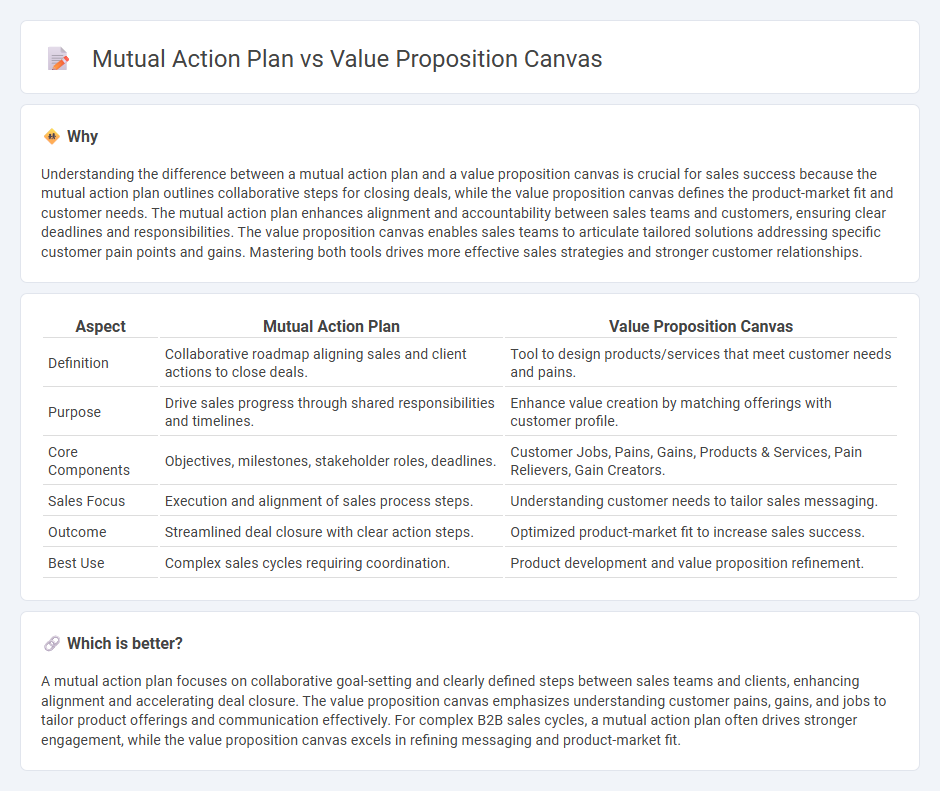
A Mutual Action Plan outlines a collaborative roadmap between seller and buyer, detailing specific steps, responsibilities, and timelines to achieve sales goals, fostering alignment and accountability throughout the buying process. The Value Proposition Canvas focuses on understanding customer needs, pains, and gains to tailor products or services that deliver maximum value, emphasizing customer-centric solutions. Explore these tools further to enhance sales strategies and drive successful outcomes.
Why it is important
Understanding the difference between a mutual action plan and a value proposition canvas is crucial for sales success because the mutual action plan outlines collaborative steps for closing deals, while the value proposition canvas defines the product-market fit and customer needs. The mutual action plan enhances alignment and accountability between sales teams and customers, ensuring clear deadlines and responsibilities. The value proposition canvas enables sales teams to articulate tailored solutions addressing specific customer pain points and gains. Mastering both tools drives more effective sales strategies and stronger customer relationships.
Comparison Table
| Aspect | Mutual Action Plan | Value Proposition Canvas |
|---|---|---|
| Definition | Collaborative roadmap aligning sales and client actions to close deals. | Tool to design products/services that meet customer needs and pains. |
| Purpose | Drive sales progress through shared responsibilities and timelines. | Enhance value creation by matching offerings with customer profile. |
| Core Components | Objectives, milestones, stakeholder roles, deadlines. | Customer Jobs, Pains, Gains, Products & Services, Pain Relievers, Gain Creators. |
| Sales Focus | Execution and alignment of sales process steps. | Understanding customer needs to tailor sales messaging. |
| Outcome | Streamlined deal closure with clear action steps. | Optimized product-market fit to increase sales success. |
| Best Use | Complex sales cycles requiring coordination. | Product development and value proposition refinement. |
Which is better?
A mutual action plan focuses on collaborative goal-setting and clearly defined steps between sales teams and clients, enhancing alignment and accelerating deal closure. The value proposition canvas emphasizes understanding customer pains, gains, and jobs to tailor product offerings and communication effectively. For complex B2B sales cycles, a mutual action plan often drives stronger engagement, while the value proposition canvas excels in refining messaging and product-market fit.
Connection
A mutual action plan aligns sales teams and clients by outlining clear, collaborative steps to achieve shared objectives, ensuring accountability and progress throughout the sales cycle. The value proposition canvas complements this by identifying customer needs and matching them with tailored product benefits, enhancing relevance and engagement in each phase. Together, they create a structured yet flexible framework that drives customer-centric sales strategies and maximizes conversion rates.
Key Terms
**Value Proposition Canvas:**
The Value Proposition Canvas centers on identifying customers' pains, gains, and job-to-be-done to tailor products and services precisely to market needs, enhancing value delivery and customer satisfaction. It breaks down into two core components: the Customer Profile, which maps out customer desires and challenges, and the Value Map, which aligns products and services with those specific needs. Explore how leveraging the Value Proposition Canvas can transform your customer engagement strategy by learning more today.
Customer Segments
The Value Proposition Canvas centers on deeply understanding Customer Segments by mapping their pains, gains, and jobs to be done, enabling tailored product and service development. The Mutual Action Plan focuses on aligning both seller and customer actions toward shared goals, emphasizing collaboration and progress tracking during the sales process for specific segments. Discover how integrating these frameworks enhances customer engagement and drives targeted growth strategies.
Value Map
The Value Map in a Value Proposition Canvas highlights how products or services create customer value by addressing jobs, pains, and gains, emphasizing targeted solutions and benefits. In contrast, a Mutual Action Plan outlines collaborative steps and timelines to achieve shared goals, focusing on structured customer-seller alignment rather than detailed value creation. Explore more to understand how integrating the Value Map into strategic planning can optimize customer engagement and success.
Source and External Links
What is the Value Proposition Canvas? - The Value Proposition Canvas is a framework that helps align a product or service with customer needs, focusing on customer profile (jobs, pains, gains) and value map (products & services, pain relievers, gain creators).
How To Use The Value Proposition Canvas - 10 Step Guide - This guide provides a step-by-step process for using the canvas, from identifying and prioritizing customer jobs, pains, and gains to linking product benefits directly to those needs and testing propositions with customers.
Value Proposition Canvas - Download the Official Template - The official resource offers a downloadable template and a quick overview, emphasizing the tool's role in achieving product-market fit by precisely defining customer profiles and visualizing value creation.
 dowidth.com
dowidth.com